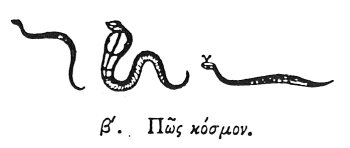
Masonic, Occult and Esoteric Online Library
The Hieroglyphics of Horapollo
By
How the Universe

When they would represent the universe, they delineate a SERPENT bespeckled with variegated scales, devouring its own tail; by the scales intimating the stars in the universe. The animal is also extremely heavy, as is the earth, and extremely slippery, like the water: moreover, it every year puts off its old age with its skin, as in the universe the annual period effects a corresponding change, and becomes renovated. And the making use of its own body for food implies, that all things whatsoever, that are generated by divine providence in the world, undergo a corruption 1 into it again.
Footnotes
I. II. III. The three species of serpents found upon the monuments.
The figures of the god Atmou sometimes exhibit instances of a serpent with its tail in its mouth. See Pl. I. fig. 1. Perhaps the nearest known approximation to the text is the serpent running round the lid of the sarcophagus of Ramesses III. at Cambridge, which rusts its head upon its tail, and may indicate the Universe.
8:1 De Pauw proposes ε?ς αυτ?, or ε?ς α?τ?, which Leemans adopts. But it simply refers to the ancient doctrine of Generation and Corruption. See Arist. de Gen. et Cor.
